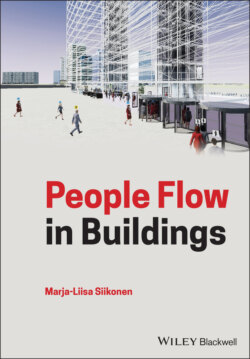Читать книгу People Flow in Buildings - Marja-Liisa Siikonen - Страница 36
3.2.2 Example of Passenger Arrivals Through Security Cages
ОглавлениеPassenger transfers through security gates in an elevator lobby is analysed to find out if the passenger arrivals follow Poisson process. Security gates provide an accurate passenger counting method in and out from an office building. With the registered security gate data, passengers are detected automatically and there is no place for human errors in passenger counting.
Figure 3.4 shows an example of the originally recorded data for a 10‐minute period from the morning up‐peak with a one‐second resolution and another from the evening down‐peak. One can notice in the morning at most two persons have arrived during the same second, while in the evening down‐peak situation even three persons have departed simultaneously from the elevator lobby through different turnstiles.
Figure 3.4 Passengers entering (a) and exiting (b) through turnstiles for a 10‐minute peak traffic period.
The combined inter‐arrival times of the sequential passenger arrivals and departures through the security gates are shown in Figure 3.5. The mean inter‐arrival time is 6.5 seconds for the entering passengers during the first 10 minutes in the morning up‐peak (Figure 3.4a), and 2.5 seconds for the exiting passengers during the evening down‐peak (Figure 3.4b). The mean inter‐arrival time is 4.6 seconds during the busy hours between 8:00 and 18:00 o'clock. Since the elevator lobby entrance has five turnstiles, for one turnstile the mean inter‐arrival time is 23 seconds on average. The first the person shows the access card and then waits for the gates to open before walking through the turnstile. It takes about three to five seconds for one person to move through a security gate. Since the average inter‐arrival time is over 20 seconds, there will be queuing only at peak traffic periods. During the evening down‐peak traffic, the passenger arrival rate is 24 persons per minute and random crowding in front of the turnstiles may appear.
Figure 3.5 Combined inter‐arrival times of entering and exiting people through security gates.
A Chi‐square homogeneity test is done to discover if the arrivals through the turnstiles follow a Poisson process. The test is applied to the automatically recorded data for the traffic peak periods of one hour. Each traffic period is analysed for intervals t of 10, 30, 60 and 300 seconds. The expected frequency, ei, of passenger groups with ki persons within interval t is
(3.2)
where ei follows Poisson process. N is the sum of the frequencies fi of all groups K during the interval
(3.3)
Index i = 1,2,…,K refers to the recorded passenger group sizes during the analysed period. The arithmetic mean of the group sizes is calculated from the recorded data as
(3.4)
The variance of the recorded group arrivals, σ2, is respectively
(3.5)
A Chi‐square – test is performed for the recorded group arrival frequencies fi, and the expected group frequencies ei
In the null hypothesis H0, we assume that passenger arrivals follow a Poisson distribution with a significance level of 0.05. The null hypothesis is accepted if the calculated value of Eq. (3.6) is less than the critical value of X20,05., and bigger than X20,95. To find critical values for the distribution, the degrees of freedom, n, during an interval is defined as the number of the analysed passenger groups minus one. The X2‐test is done separately for the people entering and exiting during the whole day, during the morning up‐peak between 8:00 and 9:00 o’clock and in the evening down‐peak between 17:00 and 18:00 o’clock. The analysis results for the passengers entering the elevator lobby are shown in Table A.2 and Table 3.1, and for the people exiting in Table A.3 and Table 3.2, respectively.
According to the Chi‐squared test, in this office building the individual passenger arrivals through the security gates follow a Poisson process only during very light traffic. H0‐hypothesis applies only for the entering passenger traffic in the evening and for the departing passenger traffic in the morning. These traffic components are opposite to the main people flow through the turnstiles. For whole day and for heavy traffic peaks, the H0‐hypothesis is rejected. With heavy traffic, the randomness of passenger arrivals may be disturbed by the turnstiles, especially in the analysis of 10‐second intervals. Thus, most time of the day the assumption that passenger arrivals through turnstiles follow Poisson process is not true.
